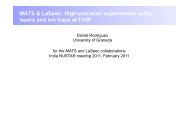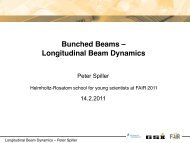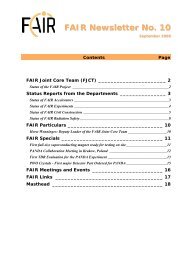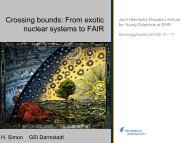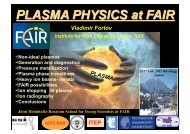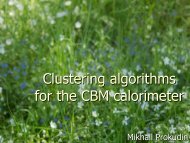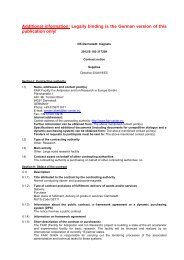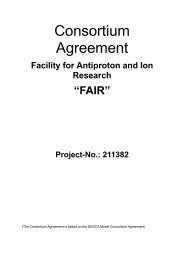CRYRING@ESR - Facility for Antiproton and Ion Research
CRYRING@ESR - Facility for Antiproton and Ion Research
CRYRING@ESR - Facility for Antiproton and Ion Research
You also want an ePaper? Increase the reach of your titles
YUMPU automatically turns print PDFs into web optimized ePapers that Google loves.
10 Chapter 2. Scientific Motivation<br />
or unwanted spectator electrons. The interpretation of the experiments is thus straight<strong>for</strong>ward<br />
<strong>and</strong> without ambiguity. In addition, the inverse processes of many fundamental atomic <strong>and</strong><br />
nuclear reaction <strong>and</strong> decay mechanisms only become experimentally accessible if corresponding<br />
vacancies in the atomic shell are available. Examples of these inverse effects include radiative<br />
recombination (inverse of photoeffect), dielectronic capture (inverse of autoionization), bound<br />
state beta decay (inverse of nuclear electron capture, EC) or nuclear excitation by electron<br />
capture (inverse of internal conversion).<br />
Low-energy phase space of cooled ions provide extremely well-defined experimental conditions<br />
<strong>for</strong> precision spectroscopy experiments (electrons, ions, <strong>and</strong> photons). At the same time,<br />
compared to ions at rest, orders of magnitude higher luminosity in collision experiments using<br />
low-energy ions in a storage ring is achieved due to the repeated interaction of the stored ion<br />
beam with a target (gas, free electrons, laser). These luminosities may be comparable to or even<br />
exceed those obtainable in single-pass fixed-target experiments while the dilute targets induce<br />
only a minimum amount of angular <strong>and</strong> energy straggling which can be compensated by beam<br />
cooling <strong>and</strong> guarantee <strong>for</strong> single collision conditions.<br />
For atomic collision studies, another appealing aspect is the very strong perturbation to<br />
the target atoms due to the impact of the slow highly charged ions with conditions far from<br />
equilibrium. CRYRING operates in a particular interesting energy range <strong>for</strong> nuclear reactions,<br />
that is at the Coulomb barrier <strong>and</strong> in the astrophysically relevant Gamow window of p- <strong>and</strong> rpprocesses<br />
of nucleosynthesis. The swift low-energy beam also makes the detection <strong>and</strong> monitoring<br />
of primary <strong>and</strong> secondary ions either in a destructive manner with particle detectors or in a<br />
non-destructive manner down to the level of single particles by means of Schottky techniques<br />
experimentally much easier. Hereby, the storage ring itself serves as a high-resolution magnetic<br />
heavy ion spectrometer. The dynamic range that is covered with the various experimental<br />
techniques covers the span from single stored ions, detected by means of Schottky noise analysis<br />
up to beams at the space charge limit.<br />
As stated in a previous section, the capabilities <strong>for</strong> future research on atomic, nuclear,<br />
<strong>and</strong> astrophysics with a combined CRYRING <strong>and</strong> ESR facility will be outlined in a dedicated<br />
“Physics book: <strong>CRYRING@ESR</strong>” which is in preparation. The current draft of the physics<br />
book is appended to this document. Moreover, since by the installation of <strong>CRYRING@ESR</strong><br />
a substantial part of the heavy ion program as <strong>for</strong>eseen at FAIR <strong>for</strong> NESR <strong>and</strong> FLAIR can<br />
already be addressed, we also like to refer to the already positively evaluated physics programs<br />
as described in the FAIR documents of the contributing collaborations (SPARC [18], FLAIR<br />
[19], EXL [20], ILIMA [21], <strong>and</strong> ELISe [22]).



